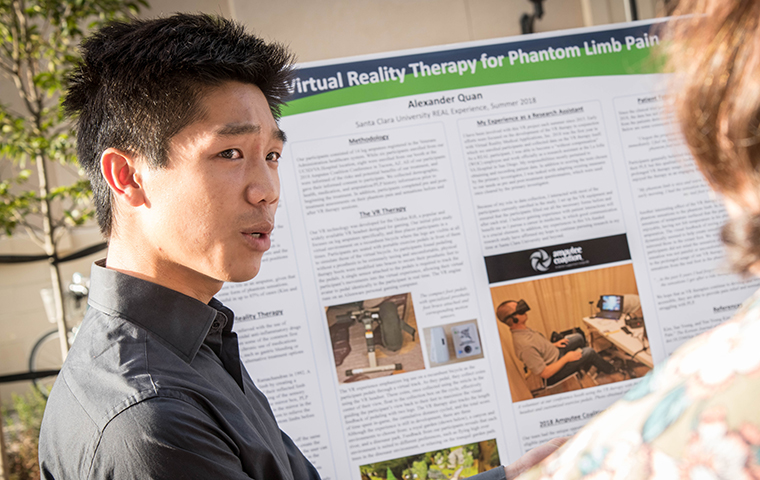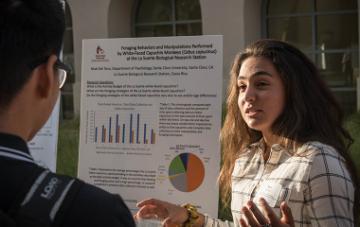
Getting REAL
Students in the College of Arts and Sciences explored their passions while being paid over the summer, thanks to $550,000 in funding through the REAL Program.
For the last few summers, Santa Clara University neuroscience major Alex Quan ’21 has been volunteering at a VA hospital where researchers are using virtual reality therapy to help amputees with phantom limb pain.
This summer was different: Not only did he finally get to work with the patients, he also got paid, thanks to a new venture at SCU called the REAL Program.
“It opens a lot of doors for opportunities that might not be possible if you don’t have outside resources,’’ said Quan, standing next to a poster board he’d assembled explaining his research with 14 amputees at the VA San Diego Healthcare System.
Eligible only to students enrolled in SCU’s College of Arts and Sciences, the REAL Program—for Real Experience, Actual Learning—addresses a frustration facing many students trying to land meaningful paid summer employment linked to their studies.
“We are excited that with this program, students can choose summer experiences based on their interests and career goals and know that their work will be funded,’’ CAS Dean Debbie Tahmassebi last week told a crowd of around 100 students, faculty, and staff.
As the onlookers gathered along the Franklin Street Arts Paseo, they could stop and chat with Quan and any of the dozens of students whose poster boards highlighted their REAL Program summer research.
“I know you are going to be blown away,’’ said Tahmassebi.

Double the funding
In its inaugural year, the REAL Program raised and distributed $550,000 to more than 127 students across 26 different majors. That averages out to about $5,000 per student over 10 weeks.
The goal for 2019, said the dean, is to double the funding—and the number of students who will be able to participate next summer. Ultimately, the College hopes to cover one paid summer internship for every undergrad student during their four years at Santa Clara.
For Quan, whose parents had covered his expenses related to his assistant research work at the VA, the REAL Program stipend allowed him to pay for daily fees like parking, and also attend a three-day national conference in Arizona devoted to innovations for amputees.
Many of them, he said, suffer from “phantom pain,” vivid and sometimes excruciating pain related to their missing limb. It’s difficult to treat because it’s not physically located in the stump, said Quan, but in pain signals within the central nervous and peripheral nervous systems.
Mirror box therapy can help some amputees. The box, which provides a reflection of the person’s intact limb, can create the illusion of the missing limb, sending a message to the brain and alleviating the phantom pain. “But,’’ said Quan, “it can be boring to sit in front of a mirror doing exercises, and many patients may lose interest.’’
VR therapy is based on the same concept. If a mirror can create the illusion of a restored limb, then a virtual environment in which the user can manipulate virtual limbs–sitting on a virtual recumbent bike as the patient pedals through a virtual track, for example–could possibly relieve phantom limb pain.
“In terms of overall success, the data analysis isn’t finished,’’ he said. “But from what I saw, they generally responded well.’’
Looking for Beetles Up High
Just down the way from Quan, biology major Anna Hooker ’19 led interested viewers through a tableau depicting her summer job collecting and gathering data on montane leaf beetles in the Eastern High Sierra.
Global warming, she said, causes the beetles—which prefer cooler weather—to retreat to higher elevations, where they have less oxygen and are slower to reproduce.
Yet the same beetles about 40 miles south have genetic variations that allow them to handle the hotter climate at higher elevations and lower oxygen. What gives?
“We are studying what is happening to their genetic variations that helps them tolerate stress,’’ Hooker explained. And understanding the evolution of how organisms respond to climate change can be broadly applied to other animals and plants, she said, including crop plants that humans depend on like wheat, corn and rice.
Like many others, Hooker learned about the new program from a faculty member, in this case her SCU biology lab professor, Elizabeth Dahlhoff.
The research that led the 20-year-old and a small team hiking up the mountains in the Eastern Sierra Nevada to gather and later test the beetles was by far the most rewarding summer job she’d had during college.
“It allowed me to focus on something I’m interested in, and that I can apply to the rest of my life,’’ said Hooker, 20, who hopes to pursue a career in biotechnology.
Somewhere in the Canopy
Right next to Hooker, anthropology/public health major Noel Del Toro ’21 had fashioned a smaller poster that charted her field work on the foraging habits of white-faced capuchin monkeys in Costa Rica.
She’d jumped at the chance to travel to Central America with SCU associate professor of anthropology Michelle Bezanson to study the monkeys. Like many species in that part of the world, they are increasingly being impacted by deforestation.
“We were diving into their environment to learn about how they are using their environment and the skills they have to compete in their daily lives,’’ she said. Del Toro also studied what the monkeys ate, because as their habitats get smaller and smaller, humans may be able to conserve the monkey population by creating corridors with the kinds of plants that they eat.
Still, searching for the primates from 5:30 a.m. to 4 p.m. in the forest canopy in order to observe and record their behavior was a lesson in patience, Del Toro admitted.
“It was definitely frustrating at certain points looking for them,’’ she recalled. “Sometimes you just have to take a step back and wait. You can’t force nature.’’
But without the REAL Program, Del Toro, 19, doubts she would have ever had the experience and stipend that goes with it to participate in such research.
“When you think of going into a rainforest to study monkeys, and be paid, most people don’t get to do that unless they are primatologists,’’ said Del Toro, who urges everyone in the College to apply to the program.
“It’s something you are probably never going to have the opportunity to do again.’’
For more information about the REAL Program, click here.